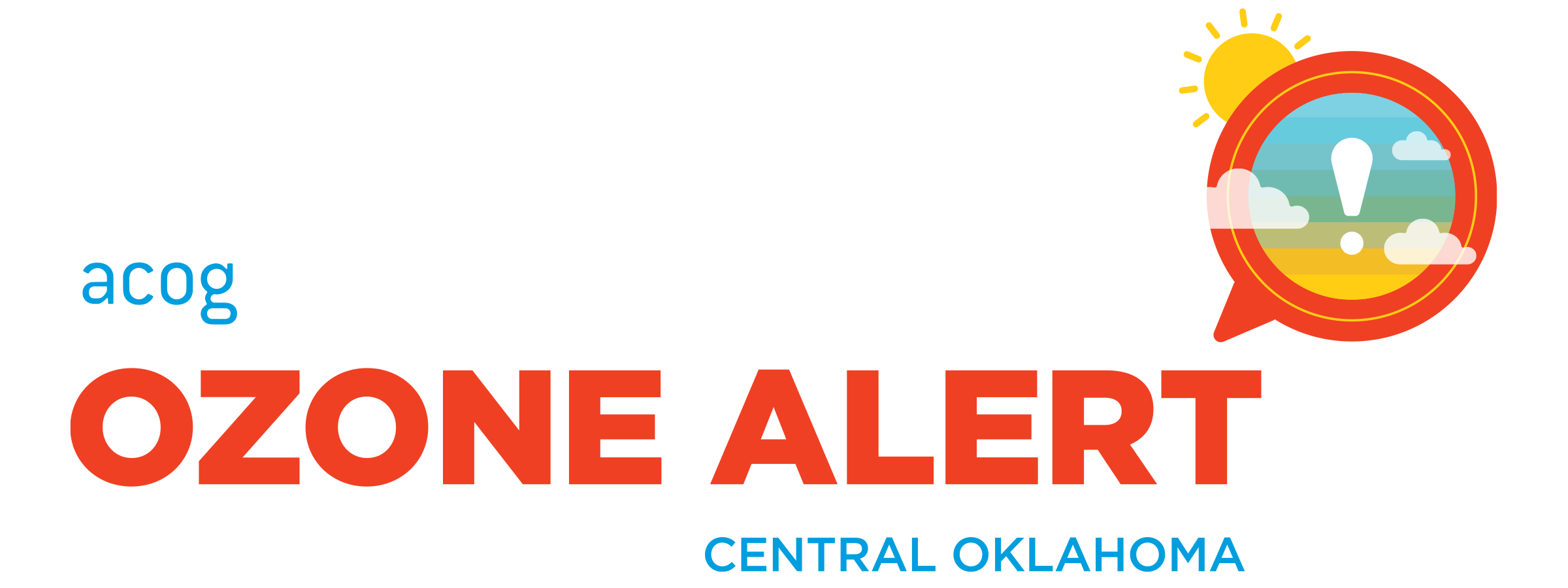ACOG: More Emissions Reduction Efforts Needed as Ozone Season Begins in Central Oklahoma
Likely violation of EPA air quality standards increases urgency; Kickoff Scheduled for Thursday, April 18.


According to ODEQ, air quality monitors in Oklahoma County now detect concentrations of ozone considered unhealthy for sensitive groups. Children and persons with asthma should avoid prolonged outdoor exertion. Persons with lung or heart disease should be aware that increased pollution may cause them to experience adverse health effects.
Ozone affects people differently. Unhealthy levels of ozone can cause throat irritation, coughing, chest pain, shortness of breath, increased susceptibility to respiratory infection and aggravation of asthma and other respiratory ailments. These symptoms are worsened by exercise and heavy activity. Children, older adults and people with underlying lung diseases, such as asthma, are at particular risk of suffering from these effects.
As ozone levels increase, the number of people affected and the severity of the health effects also increase. Persons with lung or heart disease should be aware that increased pollution may cause them to experience adverse health effects.
The Association of Central Oklahoma Governments (ACOG) will kick of Ozone Alert Day Season this week amidst concerns that the region will likely violate federal air quality standards this year. Last year, the region exceeded ozone standards set by the U.S. Environmental Protection Agency eleven times.
According to Eric W. Pollard, Clean Cities Manager, ACOG, during warmer months, emissions from a variety of sources can react with heat and sunlight to form ground-level ozone. When weather conditions project the possibility of higher ozone levels, ACOG, the Department of Environmental Quality (DEQ), and other partners call an Ozone Alert Day.
“Ozone Alert Days mean air pollution is expected to reach unhealthy levels,” Pollard said. “Ozone exposure is a health risk to the entire population, but particularly sensitive are children, the elderly, anyone with respiratory or cardiovascular illnesses, and anyone who experiences prolonged exposure.”
According to the Environmental Protection Agency (EPA) higher ozone levels correlate with increased asthma attacks and reduced lung function, increased hospitalization, and increased medication usage.
In addition to informing the public about health risks, ACOG works to inform individuals and organizations on emissions reduction actions that protect public health.
This year, ACOG will partner with the City of Mustang on the region-wide kickoff April 18, 10 AM at Mustang City Hall, 1501 N Mustang Road, with a goal of educating the media and public.
“Every community in Oklahoma can take action to improve air quality for residents,” said Tim Rooney, City Manager, Mustang, Oklahoma. “Pollution doesn’t abide by boundaries, so regional cooperation is key.”
Cleaner air gives the region an economic advantage as the Oklahoma City metropolitan area is one of the larger regions that remains in attainment of EPA air quality standards. However, it is likely that Central Oklahoma will be in violation of the ozone standard in 2019. Violation of the standard increases the OKC-metro area’s risk of going into non-attainment and that status could negatively impact economic growth and the ability to retain and recruit companies.
“Central Oklahoma needs to avoid non-attainment designation,” said Mark W. Sweeney, AICP, Executive Director, ACOG. “It could increase the cost of doing business, slow down infrastructure projects like road and bridge construction, and add new costs on individuals and families such as higher gas prices and vehicle emissions testing.”
ACOG is working with a diverse group of partners to protect Oklahomans’ health and keep the region in-attainment of air quality standards through Ozone Alert Day actions and long-term emissions reductions efforts, but expanded efforts are needed to impact air quality.
An Ozone Alert email notification sign up and a list of emissions reduction actions for individuals can be found at acogok.org.
Reduce Automobile Emissions
Use public transit like OKC’s EMBARK, Norman’s CART, or Edmond’s Citylink
Use ODOT’s Pathfinder or Google Maps traffic features to avoid idling in traffic during your commute
Carpool with friends or co-workers
Eliminate Idling (avoid drive-thru lanes)
Consolidate or delay errands, bring your lunch
Wait until nightfall to refuel your vehicle
Stop at the Click. Don’t overfill your gas tank when refueling
Conserve Energy
Turn home air conditioning thermostat up (preferably to 78 degrees or higher)
Turn off or unplug electrical devices when not in use
Check with your electricity provider for energy efficiency rebates or other incentives
Ozone Alerts
Click here to sign up to receive Ozone Alerts.
World Air Quality Index Project Team
Current air quality is provided by the World Air Quality Index Project Team.
Outdoor Activity
Delay lawn work with any gasoline-powered device
Delay outdoor burning
About Ozone
The primary component of smog, ground-level ozone is a health risk to the general populace of Central Oklahoma but especially dangerous to children, the elderly and anyone with respiratory or cardiovascular illnesses including asthma, diabetes and emphysema. Ground-level ozone forms when nitrogen oxides (NOx) and volatile organic compounds (VOCs) chemically react with sunlight on hot, windless days. NOx and VOC emissions come from a variety of sources including our cars and trucks, construction equipment, gas-powered lawn equipment and even charcoal grills.
Contact
For more information about ACOG’s air quality program, contact Eric W. Pollard, (405) 234-2264.